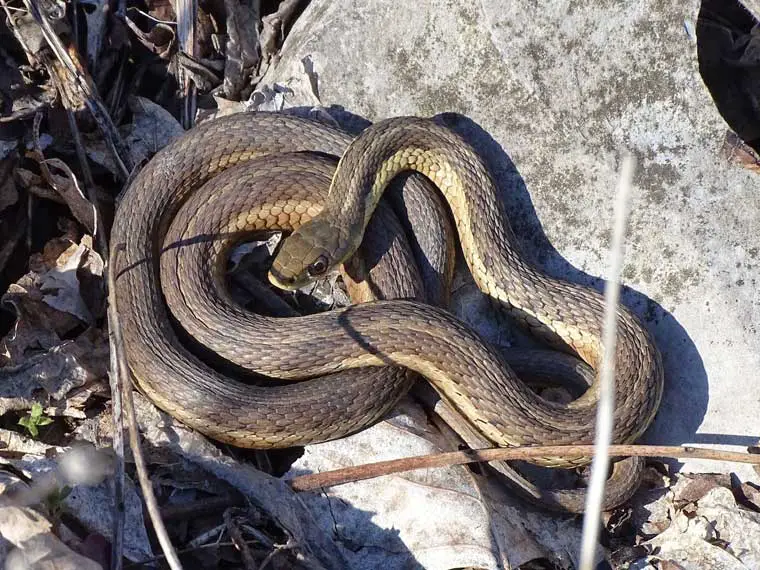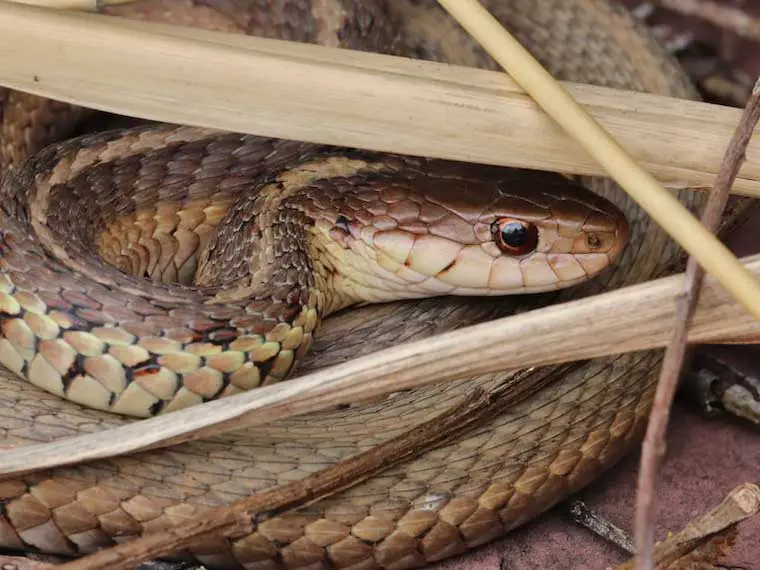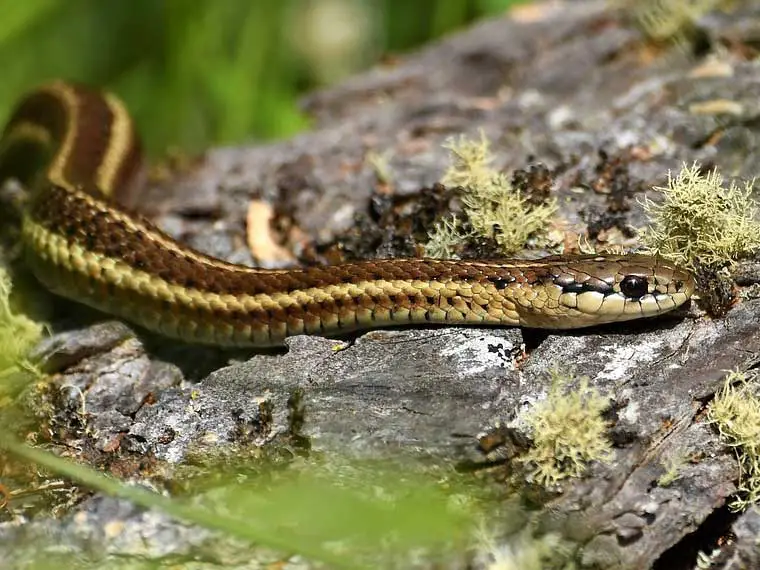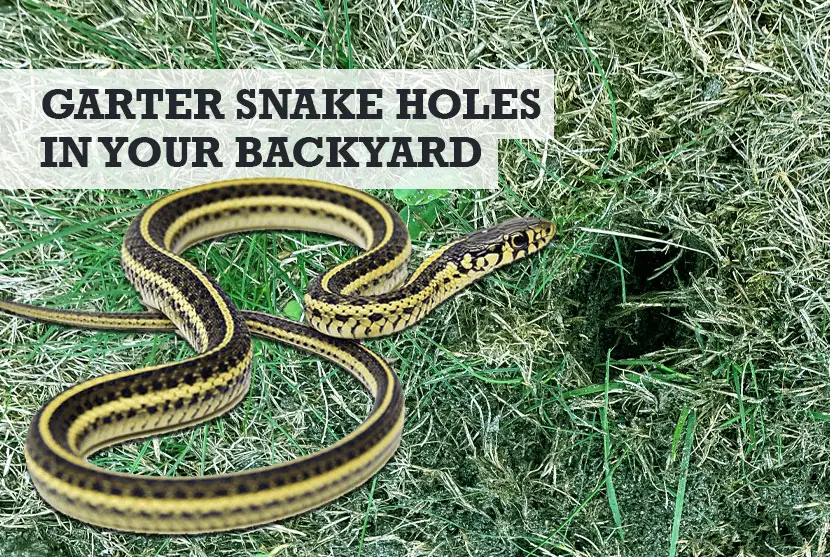Seeing a garter snake in your yard will scare many people, particularly those with small children and pets. Whilst they are not known to be aggressive snakes, they do have venom, but it’s very weak and if they bite, will in most case, just result in an irritation.
But it might be the case that you’ve not seen one in your backyard, but instead are seeing what you believe to be garter snake holes in your yard. As one of the most common snakes in the United States, those holes could very well be where a garter snake lives.
Alternatively, the holes in your yard might be nothing to do with garter snakes, the holes being there for an entirely different reason.
To help you, I’ve created this guide which explains whether garter snakes make holes in the ground in your backyard, whether they make tunnels, and how to identify them.
Handy Hint: If you are worried, you could try putting “Snake B Gon” (buy on Amazon) down the suspected garter snake holes to flush them out. It won’t kill them but can make them leave your yard.
Do garter snakes live in holes in the ground?
Garter snakes do live in holes in the ground of your yard, but not just there. The snake species likes to live in moist areas with tall grass, and from late October to early April will hibernate under rocks, log piles, or in holes.

Essentially, they are very shy snakes, and will look for a warm and safe environment that can become their home. This means that they will be attracted to cracks in soil and small holes in the ground of your backyard where they can hide from you and predators.
Do garter snakes dig holes and tunnels?
It’s a huge misconception that garter snakes dig holes and tunnels in yards to live in. It’s not true, garter snakes cannot dig holes, or excavate into soil.
What instead they will do, is find holes that have been made by other animals, and then take them over.
For example, animals that are likely to have made holes in your yard include moles, voles, rats, squirrels, and chipmunks. A garter snake will happily use a hole one of these creatures have made.
Reptiles the size of garter snakes cannot dig holes. The most they can do is make spaces in soft soil like you might get on a compost heap. Garter snakes cannot make snake holes in compacted soil, the type of which you get in yards and garden lawns.
Handy Hint: Here are photos of vole holes so you know what to check for.
What kind of snakes can make holes in the ground then?
So, if it’s not garter snake holes in your yard, what snakes can make holes. Thankfully not many, and certainly not the ones you probably have in your backyard in the United States. Excavating snakes are likely to be found in Asia and Africa, according to this website:
“The snakes that are found in the places where there are loose substrates, they are known to be the best excavators and they are the sand boas, black headed pythons and womas. The problem is that the loose sand may not retain the right structure of the right burrow so the snakes may end up burying themselves.”
Is it bad to have garter snakes in your yard?
Given how ubiquitous garter snakes are, I wanted to calm your fears, as seeing a snake slither down a hole in your yard will make most people very nervous.
Firstly, I think it’s great when you have garter snakes in your yard. Whilst they might send a shiver up your spine, please take a deep breath, and appreciate them for what they are.
They are often referred to as the gardener’s friend, and some people even think their proper name is the gardener snake… and with good reason on both counts.

The bottom line is that it’s not a bad thing to have garter snakes in holes in a yard or garden. As a keen gardener they can help you by eating slugs, grasshoppers, grubs, and other insects that might otherwise harm your plants.
Garter snakes will also eat rodents.
For gardeners this is good news. For example, if you see garter snakes living in holes in your yard, it means they have chased off or eaten other animals that have made those holes.
This can include chipmunks and moles, both of whom can do structural damage to property when digging tunnel networks. They can also dig leading to lawns collapsing, and chipmunks will eat vegetation too that you might be growing.
Here are how to spot the differences:
But it’s not always good news when you find garter snake snake holes in a yard.
Garter snakes can be bad for gardens and yards if you have a pond. They will prey on frogs and toads and will also eat earthworms that will contribute to your backyard’s ecosystem.
Hopefully though, if you have garter snakes living in holes in your backyard, a happy balance can be created.
How do garter snakes make holes in the ground?
So, to summarize, garter snakes do not make holes in the ground. Instead, they will find an existing hole and take it over. This might mean preying on the current inhabitant, finding an empty hole, or scaring another creature away.
How to find garter snakes in your backyard?
Aside from the garter snake holes in your yard, you can also find them hiding out in tree hollows, under wood and log piles, under rocks, or in cracks in the ground.
Some people will encourage them into their backyard by creating the perfect habitat. This includes a water source, letting grass grow, and possibly putting down piles of logs or metal sheets on the ground.
What do garter snake holes look like?
As I’ve established, garter snake holes tend to originally be holes dug and created by other creatures, there’s no guarantee of being able to identify a garter snake hole. It could like any small and suitable backyard hole in truth.
However, this species will like tunnels with small hole entrances. They want a small hole no more than a couple of inches in diameter to feel safe in. They like comfortable, safe, and warm holes so won’t use large holes dug out by larger mammals.
Like most snakes, a garter snake can just about burrow into vegetation and leaves, but they cannot dig down and deep into compacted earth, typical of that found in backyards.
And that’s why garter snake holes will always start out belonging to another creature, rather than appearing suddenly overnight.
How to tell if a garter snake is living in a hole in your yard
The thought that there are garter snakes in the holes in your yard might send a shiver up your spine. I don’t blame you, and for those with young children and small pets it’s legitimate concern.
Garter snake holes that are an active habitat might present a few clues. Obviously, the biggest clue is seeing a garter snake in your backyard, here’s what one looks like according to the Critter Catalog.
“Common garter snakes are highly variable in color pattern. They typically have three light stripes that run along the length of their body on a black, brown, gray, or olive background. The stripes can be white, yellow, blue, greenish, or brown.”

If you’ve not seen one though, but just found what you think are garter snake pit holes, other signs include:
- Newly shed snakeskin suggests snakes live in your yard’s holes.
- Snake feces near or outside the hole offer a sign of life.
- Spiderwebs over the hole will mean there’s no snake in there.
How to get rid of garter snakes in your yard
I think finding garter snake holes in my yard is a good thing, as they will help protect against critters I don’t want. But I understand some people will be scared and want them gone.
Here’s a list of human methods you can try:
- Snake repellent (Snake B Gon on Amazon is excellent).
- Remove food sources – this can include using rodenticide.
- Remove hiding places and warmth.
- Cut your yard’s lawn and prune back bushes.
- Install a snake proof fence.
Snake B Gon does not kill garter snakes but will annoy the reptile enough by disturbing its sense of smell, to hopefully make it want to relocate away from your backyard. You sprinkle it over your yard or put into spaces and holes where the snake has been.
I know some people who will even put the product down the possible garter snake holes in their yard. You can read more tips here.
How to prevent garter snakes coming in your backyard
Once you’ve got rid of the garter snakes, you can take further steps to ensure they don’t come back. That means assessing your backyard and how it’s all put together and what type of environment you’ve created that attracts the snakes in the first place.
Here’s what you need to remove or assess to protect your backyard from garter snakes.
1. Don’t leave an environment for them to live and hide in
Snakes need warmth and hiding places so will thrive in backyards that have thick undergrowth such tall grass, bushes, wood piles, and random logs.
Is your yard in need of a mow? If it is, get that grass cut down to a tidy length of no more than a couple of centimeters, break up any wood piles, and take logs and hiding places out of your backyard
2. Take measures to rid your yard of rodents and bugs
Garter snakes also love yards that have a reliable and constant food source. If your backyard contains a healthy number of bugs, it will attract snakes. The same goes for rodents.
So, if you have a rat and mouse problem, you could also have a snake problem.
The same goes for frogs and toads. Garter snakes love them, so could be attracted to a pond or water source in your backyard.
3. Think about your garden furniture set-up
Snakes will love the shade and warmth that your garden furniture offers.
Whilst it’s impossible to get rid of your furniture, regularly check under cushions and chairs, and move things daily so snakes can’t get comfortable in making a home in your backyard.
4. Block off crawl spaces
Snakes will love a crawl space under your house as it gives them a place to hide and check out any activity in your backyard. They can sleep in there and be protected, them come out onto the yard space when it’s time to hunt for critters.
Make regular checks of crawl spaces, or better still, see if you can completely block off any access routes for snakes… they can get into the smallest of gaps.
Conclusion
I hope you’ve found this helpful, but if I can finish on one point, it’s this: just leave garter snakes alone if you suspect they are living in holes on your yard. They really are an important part of the ecosystem of your backyard and will benefit your property.
They will help to get rid of small rodents and bugs, many of which will be damaging your backyard and destroying so much of the hard work you’ve already put in.
Pouring anything down a snake hole to kill a snake is pointless, cruel, and helps nobody, particularly you.


